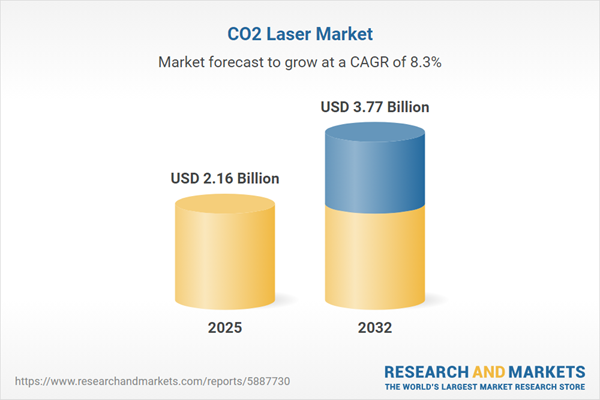Speak directly to the analyst to clarify any post sales queries you may have.
Senior executives navigating industrial transformation recognize that automating complex processes and enhancing adaptability are vital for maintaining competitiveness. As manufacturers evaluate next-generation tools and strategies, the CO2 laser market is setting new standards for process flexibility and operational resilience across key industries.
CO2 Laser Market Snapshot: Growth and Trends
The global CO2 laser market reached USD 1.99 billion in 2024 and is projected to expand at a CAGR of 8.28% through 2032. This growth reflects rising investment in automation and digitalization initiatives. As flexible and responsive manufacturing environments evolve, CO2 laser systems are now a central component for industries adapting to rapid operational shifts and regulatory requirements. End users in automotive, electronics, medical device, and packaging segments leverage these systems to streamline productivity, improve output quality, and match the pace of changing market dynamics.
Scope & Segmentation: CO2 Laser Market
- Application Areas: Metal cutting for multiple shapes and dimensions simplifies manufacturing workflows while supporting precision. Marking and engraving technologies ensure product traceability and compliance, helping companies address both internal and external regulatory audits. Precision drilling and welding enable the fabrication of intricate components, particularly valued by medical device and electronics sectors where accuracy is critical.
- Laser Technology Types: Glass tube lasers deliver cost-effective automation for price-sensitive businesses seeking an entry point. Metal waveguide lasers provide robust, reliable performance suitable for demanding industrial environments. Sealed tube lasers are preferred for streamlined maintenance, often used where extended operation and reduced downtime are priorities.
- Power Ranges: Low-power models are ideal for delicate marking and applications requiring fine control. Mid-power systems support adaptable production lines and moderate processing needs. High-power options meet the demands of high-throughput operations, enabling large-scale output without sacrificing quality.
- End Users: Automotive manufacturers target accuracy in component assembly and parts production. Electronics producers benefit from improved speed and consistency for large volumes. Medical device organizations focus on achieving regulatory compliance through robust traceability. Packaging businesses prioritize precision and uniformity in faster-paced settings.
- Regional Coverage: The market demonstrates distinct adoption patterns across the Americas, Europe, Middle East, Africa, and Asia-Pacific. Leading countries, such as the United States, China, Germany, Japan, India, and Southeast Asia, continue to advance integration based on distinct regulatory standards and sectoral priorities, reflecting regional industrial maturity and growth trajectories.
- Key Companies: Market leaders include IPG Photonics Corporation, II-VI Incorporated, TRUMPF GmbH + Co. KG, MKS Instruments Inc., Novanta Inc., Han’s Laser Technology Industry Group Co. Ltd., Heraeus Noblelight GmbH, Trotec Laser GmbH, Universal Laser Systems Inc., and Bystronic Laser AG. These organizations drive the market with ongoing innovation and tailored partnership approaches for diverse client needs.
Key Takeaways for Senior Decision-Makers
- Advances in resonator and beam technologies contribute to improved process stability, enabling more reliable and continuous production operations.
- The integration of real-time monitoring with adaptive control systems helps organizations address evolving quality standards and respond effectively to shifting regulatory requirements.
- Implementing energy-efficient CO2 laser systems, together with closed-loop recycling, supports compliance initiatives and sustainability targets while adding long-term value.
- Strengthening supplier partnerships and robust risk management strategies enhance the agility needed to respond to global supply chain disruptions and trade shifts.
- Regional market approaches reflect localized priorities: businesses in Asia-Pacific and North America favor continuous upgrades and sophisticated automation, while European organizations emphasize scalable integration of Industry 4.0 technologies for improved competitiveness.
Tariff Impact on Supply Chains and Costs
Recent shifts in U.S. tariffs are prompting manufacturers to revisit CO2 laser equipment sourcing strategies. Some expand supplier networks in Asia and Europe to reduce risk exposure, while others adopt nearshoring to stabilize procurement. Larger enterprises increasingly explore vertical integration for greater oversight, and smaller firms join cooperative purchasing groups to improve negotiating strength and adaptability. These approaches are designed to secure steady operations despite evolving cross-border regulations.
Methodology & Data Sources
This report is built upon structured interviews with original equipment manufacturers, systematic reviews of industry-leading publications, and comprehensive patent analysis. Experts in supply chain management and laser engineering have independently reviewed all findings to ensure relevance and reliability for senior decision-makers.
Why This Report Matters
- Detailed segmentation allows executives to align CO2 laser investments with operational goals and compliance expectations.
- Regional and sectoral benchmarks facilitate partnership and market-entry strategies, supporting more informed investment decisions.
- Expert-driven insights equip leaders to anticipate trends, de-risk expansion, and capitalize on opportunities with confidence.
Conclusion
CO2 laser solutions are empowering organizations to modernize production, heighten operational adaptability, and build resilient supply chains. This report serves as a strategic resource for driving growth and achieving sustainable excellence as market demands evolve.
Additional Product Information:
- Purchase of this report includes 1 year online access with quarterly updates.
- This report can be updated on request. Please contact our Customer Experience team using the Ask a Question widget on our website.
Table of Contents
3. Executive Summary
4. Market Overview
7. Cumulative Impact of Artificial Intelligence 2025
Companies Mentioned
The companies profiled in this CO2 Laser market report include:- IPG Photonics Corporation
- II-VI Incorporated
- TRUMPF GmbH + Co. KG
- MKS Instruments, Inc.
- Novanta Inc.
- Han’s Laser Technology Industry Group Co., Ltd.
- Heraeus Noblelight GmbH
- Trotec Laser GmbH
- Universal Laser Systems, Inc.
- Bystronic Laser AG
Table Information
| Report Attribute | Details |
|---|---|
| No. of Pages | 197 |
| Published | October 2025 |
| Forecast Period | 2025 - 2032 |
| Estimated Market Value ( USD | $ 2.16 Billion |
| Forecasted Market Value ( USD | $ 3.77 Billion |
| Compound Annual Growth Rate | 8.2% |
| Regions Covered | Global |
| No. of Companies Mentioned | 11 |









